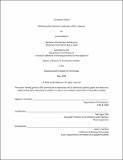| dc.contributor.advisor | Rafi Segal. | en_US |
| dc.contributor.author | Mabsout, Joude(Joud Enaam Mounir El-Mabsout) | en_US |
| dc.contributor.other | Massachusetts Institute of Technology. Department of Architecture. | en_US |
| dc.coverage.spatial | a-le--- | en_US |
| dc.date.accessioned | 2020-10-08T21:27:42Z | |
| dc.date.available | 2020-10-08T21:27:42Z | |
| dc.date.copyright | 2020 | en_US |
| dc.date.issued | 2020 | en_US |
| dc.identifier.uri | https://hdl.handle.net/1721.1/127862 | |
| dc.description | Thesis: S.M. in Architecture Studies, Massachusetts Institute of Technology, Department of Architecture, May, 2020 | en_US |
| dc.description | Cataloged from the official PDF of thesis. | en_US |
| dc.description | Includes bibliographical references (pages 70-71). | en_US |
| dc.description.abstract | Failed infrastructure initiatives have been at the forefront of Lebanon's 2019 October Revolution, a nationwide movement born from the frustrations of unjust laws and misuses of public funds. The uprising has put the government's corrupt plans in the spotlight, one of which is a national strategy of dam construction spanning the entirety of the country. This thesis re-examines how large-scale water infrastructure in Lebanon has disrupted ecologies and uprooted local communities, exacerbating existing social tensions for political gain. Visualizing river valleys as contested landscapes, this thesis explores the transition of these valleys from a constant state of destruction to places where people can reclaim their rights to the landscape. Taking the case of the Bisri Valley, where a highly contested Dam mega-project is in the process of being built, this thesis proposes an alternative future for the valley, transforming it from a politically contested dam reservoir, to an environmentally and socio-culturally preserved collective landscape. Through sectional studies, design strategies are proposed as a way to both protest the continuous threat on the landscape and offer a toolkit for action. This toolkit presents a set of interventions that allow for the activation and preservation of existing landscape ecologies and communities, amounting to a constant act of reclaiming and protecting the land. This project reimagines the landscape as a new hima, a locally rooted meaning for the commons. The proposed design operations aim to act as a prototype for collective actions of preservation and engagement, re-anchoring people with their landscape in the face of divisive projects. | en_US |
| dc.description.statementofresponsibility | by Joude Mabsout. | en_US |
| dc.format.extent | 71 pages | en_US |
| dc.language.iso | eng | en_US |
| dc.publisher | Massachusetts Institute of Technology | en_US |
| dc.rights | MIT theses may be protected by copyright. Please reuse MIT thesis content according to the MIT Libraries Permissions Policy, which is available through the URL provided. | en_US |
| dc.rights.uri | http://dspace.mit.edu/handle/1721.1/7582 | en_US |
| dc.subject | Architecture. | en_US |
| dc.title | Contested valleys : reclaiming the common landscape in Bisri, Lebanon | en_US |
| dc.title.alternative | Reclaiming the common landscape in Bisri, Lebanon | en_US |
| dc.type | Thesis | en_US |
| dc.description.degree | S.M. in Architecture Studies | en_US |
| dc.contributor.department | Massachusetts Institute of Technology. Department of Architecture | en_US |
| dc.identifier.oclc | 1196823460 | en_US |
| dc.description.collection | S.M.inArchitectureStudies Massachusetts Institute of Technology, Department of Architecture | en_US |
| dspace.imported | 2020-10-08T21:27:40Z | en_US |
| mit.thesis.degree | Master | en_US |
| mit.thesis.department | Arch | en_US |
